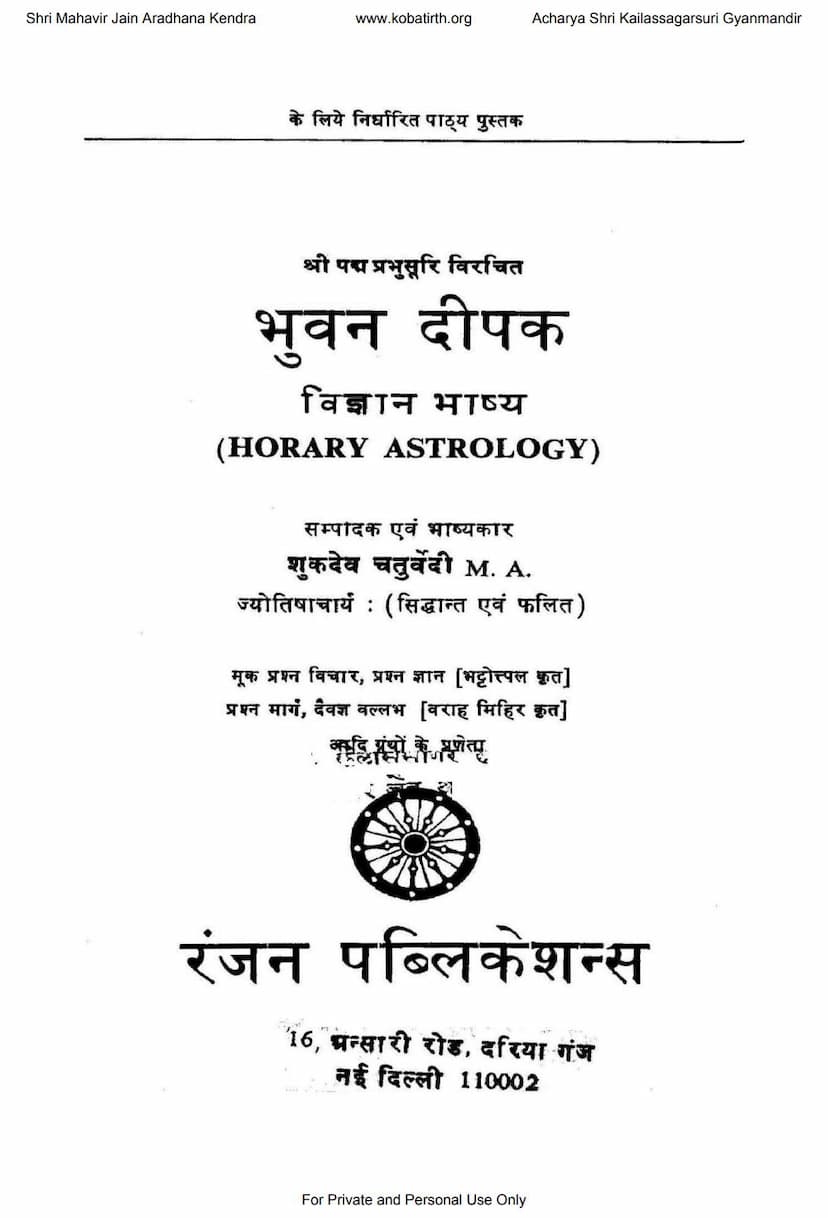Bhuvan Dipak
Added to library: September 1, 2025

Summary
The book "Bhuvan Dipak" (भुवन दीपक) by Acharya Padmaprabhusuri, with commentary by Shukdev Chaturvedi, published by Ranjan Publications, is a comprehensive treatise on Prashna Shastra (Horary Astrology) within the framework of Jain tradition. The text, originally in Sanskrit, aims to make the complex principles of Prashna Shastra accessible to a wider audience through a clear and detailed Hindi commentary.
Key aspects covered in the book, as indicated by the table of contents and chapter descriptions, include:
-
Foundational Astrological Concepts:
- Rulers of Zodiac Signs: Identifying the planetary lords of the twelve zodiac signs (Aries to Pisces).
- Planetary Positions: Details on the exaltation (uchha), debilitation (neech), and extreme exaltation/debilitation of planets.
- Inter-planetary Relationships: Understanding friendships and enmities between planets, crucial for astrological interpretation.
- Rahu and Ketu: Explaining their positions, exaltation, and debilitation.
-
Core Principles of Prashna Shastra:
- Interpretation of Houses (Bhavas): What specific questions or aspects of life are considered from each of the twelve houses.
- Determining the Time of the Question (Ishtakal): The importance of the exact time the question is asked.
- Significance of the Ascendant (Lagna) and Moon: Their roles in analyzing the query.
- Strength of Planets: Methods for assessing planetary strength.
- Yoga for Fulfillment: Identifying astrological combinations that indicate the success of an endeavor.
- Influence of "Destroyed" Planets: Understanding the impact of afflicted or weakened planets.
-
Specific Astrological Predictions and Scenarios:
- Rajayogas: Four significant yogas (planetary combinations) indicating royal or powerful status/success.
- Timing of Events: Determining the duration of events or when a query will be resolved.
- Pregnancy and Offspring: Predictions related to pregnancy, miscarriage, twin births, and the sex of the child.
- Marriage and Domestic Harmony: Analyzing marriage prospects, marital bliss, and the possibility of marrying a beloved.
- Legal Matters and Disputes: Predicting the outcome of lawsuits, fights, and other conflicts (victory or defeat).
- Sudden Gains: Identifying yogas for unexpected financial benefits.
- Travel and Foreign Dwellings: Predicting aspects of travel, including death abroad.
- Illness and Recovery: Diagnosing diseases, predicting their progression, and determining recovery.
- Theft and Missing Items: Determining if stolen goods will be recovered or if lost individuals/animals will return.
- Market Trends: Predicting the rise and fall of commodity prices (bullion and bearish trends).
-
Detailed Explanation of Astrological Factors:
- Planet Characteristics: Attributes like form, time representation, aspects (drishti), nature, taste, metal, origin, species, color, caste, abode, gender, age, and auspiciousness.
- Drishti (Aspects): Different types of planetary aspects (upward, downward, oblique, direct) and their effects.
- Qualities and Constitutions: Understanding planets' influence on the body's humors (doshas) like bile (pitta), phlegm (kapha), and wind (vata).
- Tastes: Associating planets with specific tastes (sweet, sour, salty, bitter, astringent, pungent).
- Materials and Elements: Classifying planets based on their association with metals (dhatu), roots (mool), and living beings (jeeva), and their subclasses (e.g., precious metals, herbs, bipeds, quadrupeds).
- Caste and Occupation: Assigning planets to various castes (Brahmin, Kshatriya, Vaishya, Shudra, Mlechha) and professions.
- Physical Appearance: Describing the physical characteristics associated with planetary influences.
- Colors: Associating planets with specific colors.
- Planetary Age: Categorizing planets by age (youth, child, adult, old age).
- Benefic and Malefic Planets: Distinguishing between auspicious and inauspicious planets and their impact on nature and events.
-
Practical Application and Interpretation:
- Constructing a Prashna Kundali: Detailed guidance on how to create a horary chart.
- Calculating Specific Times (Ishtakal) and Ascendant (Lagna): Essential mathematical procedures for chart casting.
- Tables of Latitudes: Providing tables for major cities in North India for accurate astrological calculations.
- Remedies: Suggestions for appeasing planets (mantras, gemstones, donations, rituals).
The book emphasizes that Prashna Shastra is a particularly useful branch of astrology because many people do not know their exact birth time, rendering natal charts potentially inaccurate. Horary astrology, by relying on the moment of the question, offers a direct method to address immediate concerns and predict future outcomes. The text also discusses different methodologies within Prashna Shastra, such as the time-based (samay siddhanta), breath-based (swar siddhanta), and letter-based (prashnakshar siddhanta) approaches, highlighting the time-based method as the most scientific and prevalent.
In essence, "Bhuvan Dipak" serves as a foundational text for those seeking to understand and practice horary astrology, drawing upon ancient wisdom and presented with modern clarity, making it a valuable resource for astrological practitioners and enthusiasts.